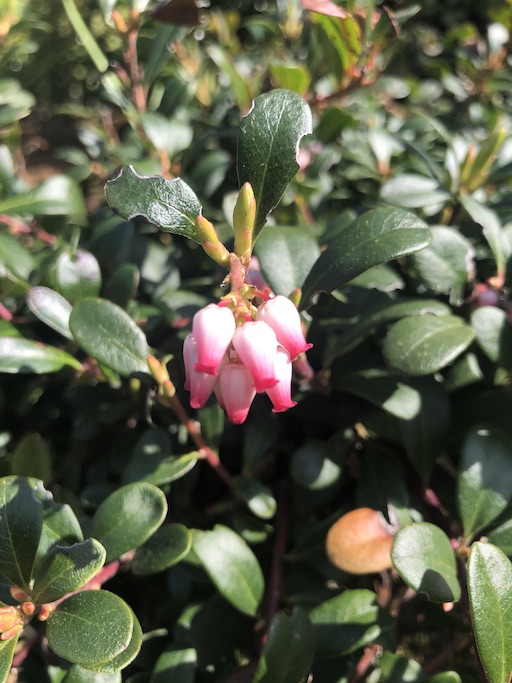Home
›
Ericaceae
›
Arctostaphylos
›
Arctostaphylos uva-ursi (kinnikinick, common bearberry)
uva – grape (Latin)
ursi – bear (Latin)
Native range: North Eurasia, North America
Leaves:
- alternate
- simple
- entire
- obtuse
- slightly revolute (rolled backwards)
- glabrous (smooth/no pubescence)
- 0.5-0.75” long

Flowers:
- inflorescence – cluster on short stalks (terminal racemes)
- flowers small, nodding, pendulous
- 5 petals, fused, urn shaped
- pink & white
- 8–10 stamen


Fruit:
- berry
- small (1/3–1/2”)
- red
Other characteristics:
- red stems
- prostrate shrub
- evergreen
Relevant info:
- sunny areas, drought tolerant
- “kinnikinnick” – Algonquin word meaning smoking mixture
- Native Americans and later early pioneers smoked dried leaves (alone or mixed with other leaves, tobacco, and/or the dry inner bark of red osier dogwood) in pipes
- Meriwether Lewis described fruits in 1806 to be “tasteless and insipid”
- example cultivars:
- ‘Massachusetts’ from seed collected in Massachusetts
- ‘Vancouver Jade’ from Victoria, BC
Ecology & Adaptations:
- Alaska south to CA and New Mexico, east to the Atlantic Coast; circumboreal
- Coastal bluffs and prairies, rocky balds, dry subalpine meadows, and dry coniferous forest
- nectar in flowers attracts pollinators (hummingbirds, bees, thrips)
- mycorrhizal associations aid drought and low nutrient tolerance
- leathery leaves last, which helps conserve nutrients in nutrient-poor soils
- fire tolerant – latent buds on the horizontal stems and dormant buds on the stem base or root crown that allow sprouting of surviving plants or root stems after fire; hard-coated seeds persist in the seedback and help population recover after fire
- fruits resistant to bacteria and fungi but attract animals, which aid in seed dispersal

